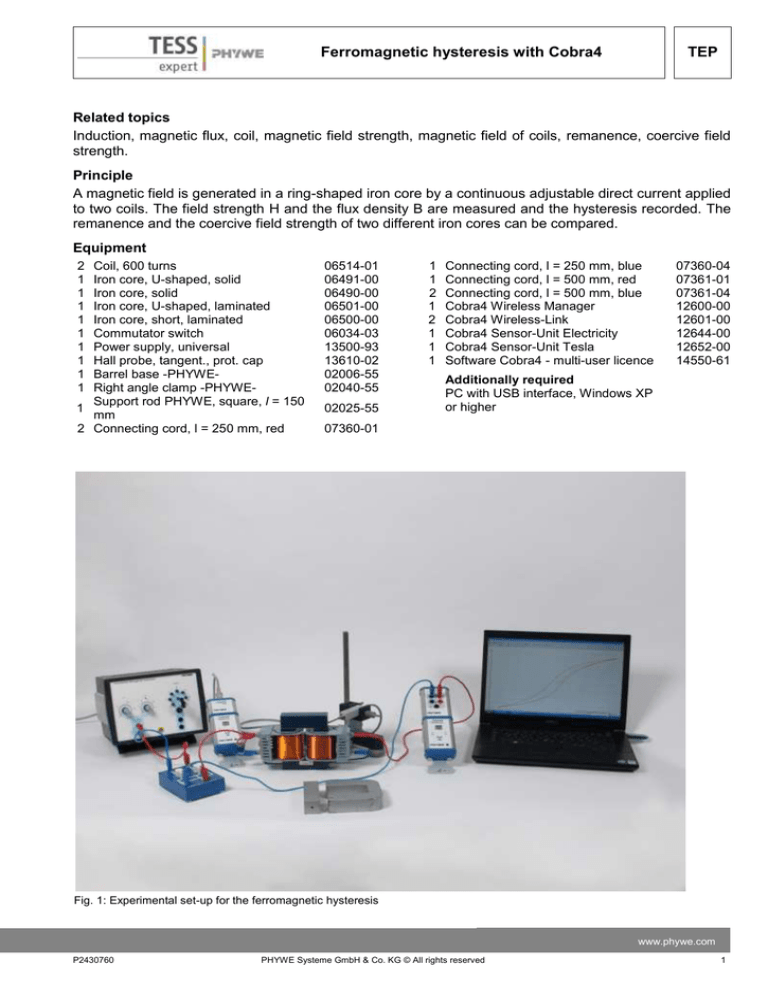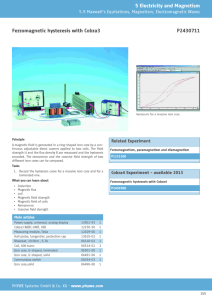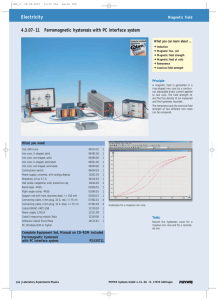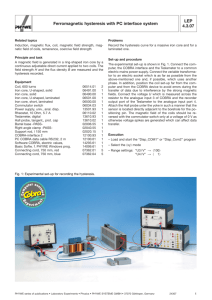
Ferromagnetic hysteresis with Cobra4
TEP
Related topics
Induction, magnetic flux, coil, magnetic field strength, magnetic field of coils, remanence, coercive field
strength.
Principle
A magnetic field is generated in a ring-shaped iron core by a continuous adjustable direct current applied
to two coils. The field strength H and the flux density B are measured and the hysteresis recorded. The
remanence and the coercive field strength of two different iron cores can be compared.
Equipment
2
1
1
1
1
1
1
1
1
1
Coil, 600 turns
Iron core, U-shaped, solid
Iron core, solid
Iron core, U-shaped, laminated
Iron core, short, laminated
Commutator switch
Power supply, universal
Hall probe, tangent., prot. cap
Barrel base -PHYWERight angle clamp -PHYWESupport rod PHYWE, square, l = 150
1
mm
2 Connecting cord, l = 250 mm, red
06514-01
06491-00
06490-00
06501-00
06500-00
06034-03
13500-93
13610-02
02006-55
02040-55
02025-55
1
1
2
1
2
1
1
1
Connecting cord, l = 250 mm, blue
Connecting cord, l = 500 mm, red
Connecting cord, l = 500 mm, blue
Cobra4 Wireless Manager
Cobra4 Wireless-Link
Cobra4 Sensor-Unit Electricity
Cobra4 Sensor-Unit Tesla
Software Cobra4 - multi-user licence
07360-04
07361-01
07361-04
12600-00
12601-00
12644-00
12652-00
14550-61
Additionally required
PC with USB interface, Windows XP
or higher
07360-01
Fig. 1: Experimental set-up for the ferromagnetic hysteresis
www.phywe.com
P2430760
PHYWE Systeme GmbH & Co. KG © All rights reserved
1
TEP
Ferromagnetic hysteresis with Cobra4
Tasks
Record the hysteresis curve for a massive iron core and for a laminated one.
Set-up and Procedure
The experimental set-up is shown in Fig.1. Position the coil set-up far from the computer and from the
Cobra device to avoid errors during the transfer of data due to interference by the strong magnetic fields.
Put the Sensor-Unit Tesla on the first Wireless-Link, the Sensor-Unit Electricity to the second one and
connect the voltage U which is measured across the resistor to the current input of the Sensor-Unit Electricity. Connect the cable of the Hall probe with the Sensor-Unit Tesla and attach the Hall probe under
the yoke in such a manner that the sensor is located directly adjacent to the borehole for the positioning
pin. The magnetic field of the coils should be reversed with the commutator switch only at a voltage of
0 V as otherwise voltage spikes are generated which can affect data transfer. The flux density B0, measured by the hall probe, and the current I through the coils are recorded.
Load the experiment. (Experiment > Open experiment). All pre-settings that are necessary for the measurement are now carried out. If residual magnetism is present in the iron core, demagnetise the core as
follows: Set the commutator switch in such a manner that an opposing
field is generated. Briefly increase the voltage far enough for the flux
density to assume a zero value; repeat a number of times. Set the current limiter on the power supply to 5 A.
After pressing the icon ”Start measurement”
, increase the voltage
slowly and uniformly from zero upwards and decrease it to zero again. Fig. 2: Saving measurements.
Using the commutator switch reverse the polarity of the voltage. Again
increase and then decrease the voltage slowly and uniformly. Once again
reverse the polarity of the voltage with the commutator switch and increase the voltage. Click on the
icon in the icon strip to end measurement and reset the voltage to 0 V. Transfer all measured data to
“measure” and save the measured data by clicking on the menu prompts “File” and “Save measurement”
(Fig 2). The recorded values are represented graphically as flux density as a function of field strength.
Now change the function of the calculated channel (right click on “Virtual devices””Setup”; mark the
corresponding channel and click on “edit” (Fig. 3)) to “02I*2459” (Fig. 4). Save these settings, start a new
measurement and repeat the experiment with the laminated iron core.
Fig. 3: Virtual device.
2
Fig. 4: Calculated channel.
PHYWE Systeme GmbH & Co. KG © All rights reserved
P2430760
Ferromagnetic hysteresis with Cobra4
TEP
Remarks
The flux density should not exceed 1000 mT because of the sensor.
Theory and evaluation
The field strength is calculated with the formula
where
H = field strength
n = number of turns in the coil (600 turns)
L = average field line lengh in the core.
(solid core: L = 232 mm laminated core: L = 244 mm)
The factor n/ L changes due to the different dimensions of the two iron cores as follows:
Solid iron core: n/ L = 2586 in 1/m
Laminated iron core: n/ L = 2459 in 1/m
The calculation of the field strength is combined with a change of the x-axis in the visualisation.
The factor in the mathematical ”Operation” depends on the used iron core and is equal to n/ L.
Now, the coercive field strength and the remanence can be extracted from the hysteresis. Therefore, use
the ”zoom” function in the region of the intersection of the axes and then choose ”survey” to obtain the
points of intersection of the x and y-axis with aid of the cursor lines, which can be freely moved and
shifted. A comparison of Figs. 5 and 6 shows that the remanence and coercive field strength are substantially greater in a solid iron core than in a laminated one.
Typical values for this experimental set-up are:
iron core:
massive laminated
coercive field strength:
436 A/m 80 A/m
remanence:
143 mT 41 mT
Fig. 5: Hysteresis of a massive iron core.
www.phywe.com
P2430760
PHYWE Systeme GmbH & Co. KG © All rights reserved
3
TEP
Ferromagnetic hysteresis with Cobra4
Fig. 6: Hysteresis of a laminated iron core.
4
PHYWE Systeme GmbH & Co. KG © All rights reserved
P2430760








